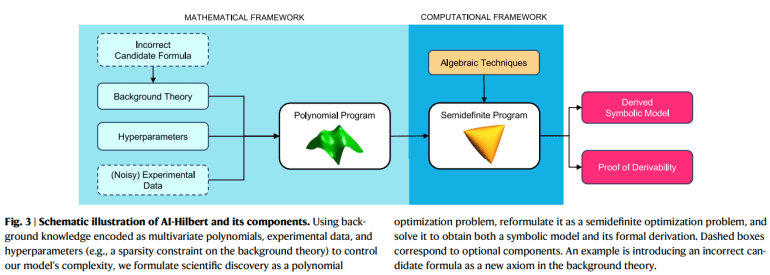- IBM, Imperial College Business School, and Samsung AI have developed AI-Hilbert, a framework combining algebraic geometry and mixed-integer optimization.
- AI-Hilbert models scientific axioms and laws as polynomials and solves optimization problems using binary variables and logical constraints.
- The method is validated with Positivstellensatz certificates and can derive established scientific laws like Kepler’s Law from hypotheses and data.
- AI-Hilbert contrasts with deep learning methods by ensuring results are verifiable and consistent with theoretical and experimental data.
- The framework uses fundamental definitions and notations, including scalars, vectors, matrices, and sets.
- It integrates data and theory to address inconsistent or incomplete theories and produces accurate symbolic expressions.
- AI-Hilbert has demonstrated superior performance in deriving laws and handling data inconsistencies compared to other methods.
Main AI News:
In the quest for scientific breakthroughs, the integration of algebraic geometry and mixed-integer optimization could redefine how researchers uncover new laws of nature. Traditionally, scientific discovery has relied heavily on equation manipulation and experimental validation, a process that has recently experienced stagnation due to diminishing returns in accessible insights. Addressing this issue, IBM researchers, alongside experts from Imperial College Business School and Samsung AI, have introduced AI-Hilbert, an innovative framework that promises to accelerate scientific discovery by effectively combining background knowledge with experimental data.
AI-Hilbert models scientific axioms and laws as polynomials, leveraging binary variables and logical constraints to tackle polynomial optimization challenges through mixed-integer linear or semidefinite optimization. This method is validated using Positivstellensatz certificates, offering a structured approach to deriving established laws, such as Kepler’s Law and the Radiated Gravitational Wave Power equation, directly from hypotheses and empirical data. Unlike traditional deep learning methods, which often produce unverifiable results, AI-Hilbert ensures scalable and reliable discoveries by aligning with both theoretical and experimental standards.
The framework introduces fundamental definitions and notations, such as scalars, vectors, matrices, and sets, essential for understanding its optimization processes. By employing Putinar’s Positivstellensatz, AI-Hilbert aims to discover polynomial models that are both theoretically sound and consistent with experimental data, while maintaining a degree constraint. The optimization problem balances the model’s fidelity to data with the theoretical hypotheses, controlled by hyperparameters.
AI-Hilbert not only identifies polynomial laws that align with background knowledge and experimental data but also provides formal proofs of consistency, inspired by David Hilbert’s theories on non-negative polynomials. In cases where background theories are inconsistent, AI-Hilbert can pinpoint the sources of inconsistency and select the most accurate hypotheses to explain the data. This approach contrasts sharply with data-driven methodologies, which may yield misleading results when faced with limited or inconsistent data.
The framework’s strength lies in its ability to integrate data and theoretical knowledge, reducing the search space for potential discoveries and addressing incomplete or noisy data. By formulating and solving a polynomial optimization problem, AI-Hilbert generates candidate formulas and formal proofs, ultimately demonstrating its capability to derive correct symbolic expressions from comprehensive background theories and outperforming other methods in various tests. This paradigm shift marks a significant advancement in how scientific discoveries are approached, offering a promising tool for future research.
Conclusion:
The introduction of AI-Hilbert represents a significant advancement in scientific discovery methodologies. By combining algebraic geometry with polynomial optimization, this framework offers a reliable and scalable approach to uncovering new scientific laws. Its ability to integrate theoretical and experimental data ensures consistency and validity in results, addressing limitations faced by traditional and data-driven methods. This innovation is likely to impact the market by enabling more accurate and efficient scientific research, potentially leading to accelerated discoveries and advancements across various scientific fields.

